Bourne Road
My parents (George and Dorothy) continued to live at 7 Bourne Road (apart from a brief spell when No 7 was remodelled and they were moved elsewhere in Bourne Road for some time -when? 50S? 60S?)
The 'Prefab' houses at Bourne Road were eventually replaced by permanent houses (when?)
Jobs
Firk's Bakery -
Wyatt's Bakery, in the narrow part of Reading Road just east of the Square, was taken over by a master baker Frank Firk and his wife Ivy from London. With them came an old experienced baker (?Harry) and son George. George was a specialist at cakes and a jazz drummer (his brother Frank Jnr never lived at Pangbourne - he had different talents and became a professor of nuclear physics at Harvard).
I worked for them on Saturdays and some holidays for a number of years, helping in the bakery and doing bread delivery rounds. The deliveries were done using a proper delivery bike, which had a very big deep basket on the front, or pushing a large wooden hand-cart. . Firk's baked quite a range of loaves, and you had to pack the cart carefully, with the different loaves in the right sequence for the round but avoiding getting the hot ones that were straight out of the over squashed. The round involved recording all the actual deliveries made, and taking the monies. I seem to remember that a small wholemeal was fourpence-farthing!
The bakery smells were marvellous. There were large lidded wooden troughs for proving the bread dough. The dough was made in the early hours, left in a trough to prove, taken out and 'knocked-back', proved some more, and then cut and moulded into loaves. Frank used to recall that when he was an apprentice the lads had to sleep on top of the troughs (which were pleasantly warm from the fermentation). When the first fermentation was through the growth in volume of the dough was such that it tipped them off onto the floor. Alarm with a difference.
The main oven was a low-arched brick oven. You loaded it by putting one or two shaped loaves onto a wooden paddle with a long handle. You pushed this into the back parts of the oven and deposited the loaves there. It was a skill to load the whole oven in the right positions and right order. Many of the loaves were 'open' ones like Farmhouse and round Coburg loaves. There were also various 'Tin' loaves where the dough went in open or lidded slab or corrugated round tins.
When the batch of bread was done you needed a spell of fairly intense teamwork. One person wielding the paddle to retrieve all the loaves and deposit them onto a side worktop, and a couple transferring them onto shelves on racks to cool - including trying to persuade the very hot tin loaves to come out of their tins. Hot work in the summer.
Apart from doing deliveries I did some jobs in the bakery. It was quite enjoyable (to start with) to take a cubic yard or so of bread dough and cut it into small hunks that weighed exactly one or two pounds. Bakers with an expert eye could do it in just one cut. Each cut hunk was then hand moulded into shape or to fit in its tin. I could do one at a time whereas the real bakers did two at once, one by each hand. Bread rolls were also hand moulded and shaped by the hundred (especially if there was a wedding or big 'do' in the village). I did manage to learn to mould two of these at once.
Apart from the bread it was fun to help George with the cakes too. Most enjoyable was making the doughnuts. Cooking the balls of dough in hot fat till they were just right, rolling in sugar and then operating a magic little device to inject each one with the right amount of strawberry jam. I became quite expert.
Frank's wife Ivy ran the shop, assisted by Betty Farr. Bank Holiday weekends and pre-Christmas were really hectic. The bakers really sweated, for hour upon hour.
Tidbury's
I also for a time worked part-time at Tidbury's, mainly serving behind the counter. They did a big trade in cigarettes. I can remember the odd toff, from 'up the hill', drawing up in their big car outside (no yellow lines), striding in and demanding 2 or 3 cartons of 200 and stalking out. If you were lucky they would snap 'put it on my account' (and you didn't have time to ask their name either).
When records became popular (the fragile shellac "78s") Tidbury's set up a record section. This was run by ___ Harrison, and his counter became a focal point for the youth of the village.
Images
A
typical Baker's Bike
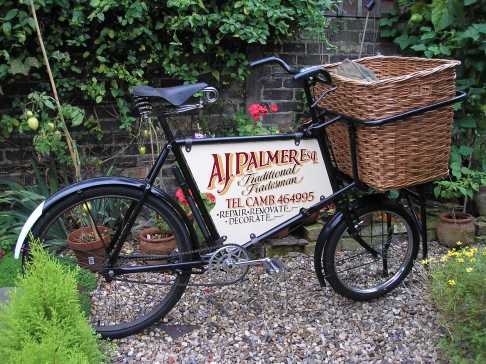
Typical Baker's Handcart
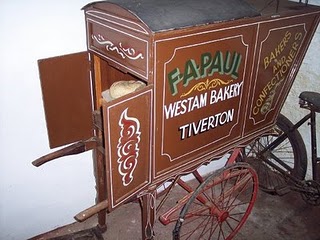
Round Loaf Pan
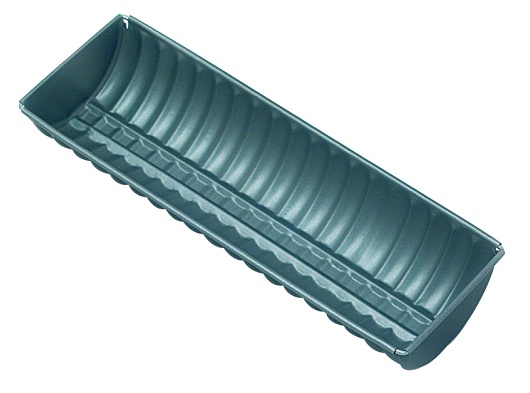
Lidded Tin
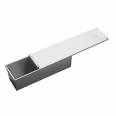
Typical bread oven unloading
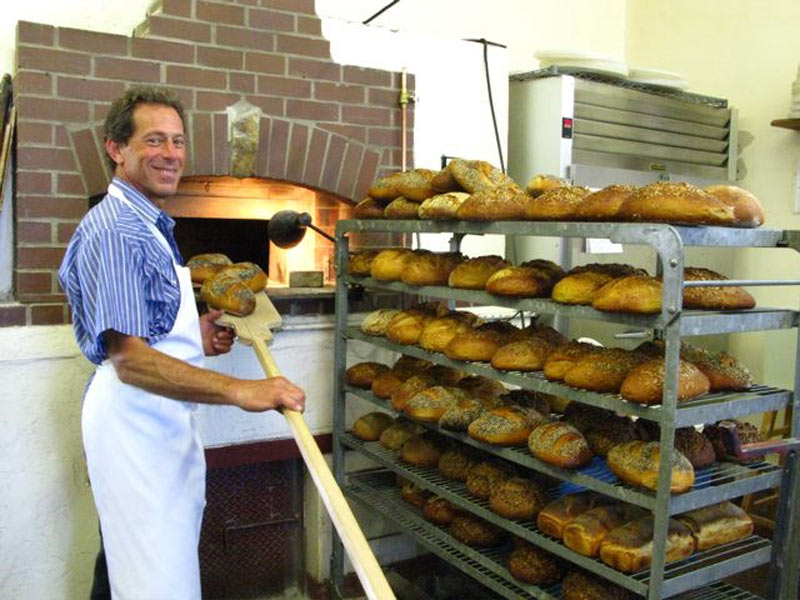
Activities
Some of the things I remember from the 40s continued.
The Bijou's travelling cinema was still a regular fixture, though it moved
to the new Village Hall.
Swimming in the Pang bathing area became harder, as it became more silted
and shallower and we became bigger. So swimming moved to the Thames, just
below Whitchurch Bridge. One had to avoid the steamers and pleasure boats,
and of course the water was dangerously deep. I know I swam across and
back unsupervised and unwatched - not the sort of thing one would want
children to do today.
Salter's Steamers were popular ways of enjoying the Thames. I seem to
remember 2 or 3 a day, going up to Wallingford and Oxford, and down to
Reading. So you could walk to say Streatley (along the Oxfordshire side)
and get a steamer back.
Most of the youngsters
of my age belonged to the Youth Club, based at the (new) Village Hall.
There were two or three energetic leaders (Myra Hunt was one) who did
a lot to organise things and keep the club going.
Arthur? Ponting started a small group up to build a canoe, using one of
the old stable buildings of the Rectory. We spent a lot of hours shaping
and bending wood. I hope all the glue fumes from joining all the rubberised
sections of the hull did us no harm....
I think the Youth Club was a Church group. Some of us did attend St James
services. I was confirmed in ____, but fortunately never progressed to
membership of the church choir. (one or two other lads did, and unfortunately
suffered abuse - the case rocked the village for some time). We had coach
outings (Bognor?) and so on.
other youth club activities
The youth of the village
did quite a number of things, apart from the Youth Club events. In the
summers we used the tennis courts at the Rec. We organised parties, even
hiring the function room of the Rosewood Hall (Working Men's Club). We
went to dance classes, held in the function room of the Constitutional
Club.
On Sunday afternoons we virtually took over the Tearoom in Whitchurch
Road, talking and eating tea and toast. Because public transport was so
good we could go to events easily.
We could go to Henley Regatta on the Saturday evening, watch the fireworks
and still get home. We could go to events at Reading Town Hall (such as
wrestling, and dances that finished quite late).
And every few Sundays there was a "Big Band" concert at the Palace Theatre
in Reading. Ted Heath; Jack Delaney; The Squadronaires; Johny Dankworth;
etc. I can also remember going to some of the Variety Shows at the Palace
- every week there was a show with a mixed bill of professional acts,
including big names, often twice-nightly. I can recall seeing Arthur Askey;
The Western Brothers; even Max Miller .
It was also very easy to get to London, so we could go up for events or
just to have tea at Lyons Corner House and a walk around. The Festival
of Britain was one big event.
As mentioned Pangbourne benefited from a very good bus service. Several routes came from Reading through Pangbourne - to Wallingford and Oxford; to Wantage; to Upper Basildon, Yattendon and East Ilsey; - perhaps even to Tidmarsh? But they were well used - I can recall queuing in the Square and failing to get on a double-decker. And coming out of Reading it was wise to get on at the terminus (Reading Station) or risk not getting on.
Sports
Quite a number of Pangbourne folk continued to watch Reading FC. My father became a season ticket holder and used to go to matches with Mr Brown, who had a shop next to the Fire Station and later in the Square. I went with them to Aldershot in Sep 1952 and while we were watching that we heard a bang - this tuned out to be the disastrous explosion at the Farnborough Airshow.The railway made it easy to get to away matches at such as Bristol Rovers and City; Swindon - the railways ran special trains, calling at Pangbourne, even for mid-week evening away games.
My school at Wallingford used to run outings to cricket Test Matches in London. I can remember cycling to Wallingford to catch these, and back, - I would not fancy riding a bike today along through Streatley and Moulsford.
I moved up from playing bar billiards at the Fire Station to playing snooker at the Constitutional Club, above the Square. Licensing laws made it difficult to use the tables in drinking hours when we were younger, but we were allowed in to play in quiet times. And we managed to get into see some of the big names play - I'm sure I saw Joe Davis and maybe Fred too.
To Add.......
......................................
Rex etc
Walks eg Sulham
TV - I can recall watching the famous Stanley Matthews Cup-Final (1953)
with a friend Colin Terry above a shop in the village.
Subsequently my father was to get a TV, still one of the first at the
Bourne Road end. Our living room was jam packed with all the locals for
Cup-Finals, peering at a very small black&white screen.)
Pangbourne Youth Club Outing in (I think) 1955
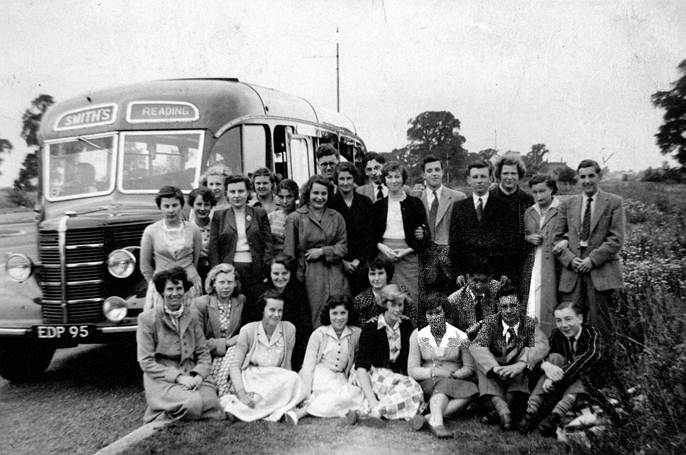
Click here for bigger image - and KEY to who is who...
Bourne
Road and the eastern part of Reading Road
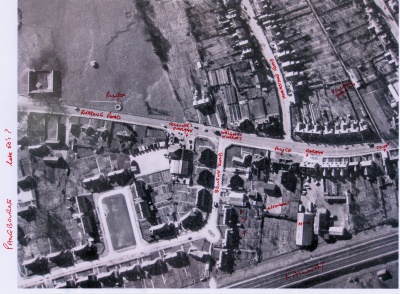
Click here for larger picture.
-----
---
